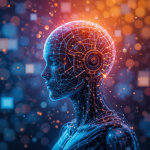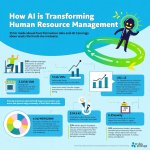How AI is Transforming Human Resource Management
In an era defined by digital disruption, Artificial Intelligence (AI) has emerged as a transformative force in Human Resource Management (HRM). From recruitment to employee engagement, performance analysis to workforce planning, AI is reshaping traditional HR functions—making them more strategic, efficient, and data-driven.The Rise of AI in HR
According to a 2023 Deloitte Global Human Capital Trends report, nearly 40% of companies have already implemented AI in their HR processes, and 70% plan to increase AI investments by 2025. This growth is fueled by the need to automate repetitive tasks, improve decision-making, and enhance employee experiences in an increasingly hybrid and competitive work environment.

1. AI is revolutionizing recruitment by automating resume screening, sourcing candidates, and even conducting initial interviews.
Example: Unilever uses AI-driven platforms like HireVue to assess candidate videos using natural language processing (NLP) and facial recognition to evaluate traits like confidence and communication skills. This approach has cut hiring time by 75% and improved diversity in candidate selection.- Stat: According to SHRM, AI-powered recruitment tools can reduce hiring costs by up to 30% and time-to-hire by over 50%.
2. AI-based chatbots and virtual assistants streamline onboarding by providing 24/7 support for new hires, reducing HR workload and improving first impressions.
Example: IBM’s Watson assists new employees with common onboarding questions and helps them complete documentation digitally.Actionable Insight: Integrate an AI onboarding assistant into your HR portal to provide real-time help, automate training schedules, and track progress.
3. Traditional performance reviews are often subjective. AI tools now analyze performance metrics, feedback, and behavioral data to offer objective insights.
Example: Betterworks uses machine learning to provide real-time feedback and continuous performance tracking, aligning employee output with organizational goals.
Stat: A McKinsey study showed that companies using AI in performance evaluations reported a 20% improvement in employee satisfaction and reduced turnover.
Actionable Insight: Use AI platforms that integrate with productivity tools (like Slack, Jira, or Microsoft Teams) to monitor employee engagement and generate real-time performance dashboards.
4. AI can detect early warning signs of disengagement by analyzing communication patterns, survey results, and even sentiment in emails and chat messages.
Example: Microsoft Viva Insights uses AI to identify burnout risks by tracking collaboration overload and recommending solutions like "focus time" or workload adjustments.
Actionable Insight: Deploy AI sentiment analysis tools to continuously monitor employee morale and address issues proactively through personalized interventions.
5. Bias in hiring and evaluation is a longstanding HR challenge. AI can help minimize unconscious bias by anonymizing applications and applying consistent criteria across candidates.
Example: Textio analyzes job descriptions to remove biased language and increase inclusivity, leading to a more diverse applicant pool.
Stat: A LinkedIn report revealed that companies using AI to support DEI initiatives experienced a 19% increase in diverse hiring outcomes.
Actionable Insight: Audit your current hiring and evaluation tools for bias and implement AI solutions that ensure fair, consistent, and inclusive practices.
6. AI can predict future hiring needs, identify skills gaps, and optimize workforce allocation using big data.
Example: GE uses AI to forecast workforce trends and succession planning, ensuring readiness for future skill demands.
Actionable Insight: Use predictive modeling tools to assess future staffing needs and build tailored learning and development plans to reskill employees accordingly.
Challenges and Ethical Considerations
Despite its benefits, AI in HR isn't without concerns:
Data privacy and security: Handling sensitive employee data requires stringent governance and compliance.
Bias in algorithms: AI is only as unbiased as the data it's trained on.
Lack of human touch: Over-reliance on AI can dehumanize processes that need empathy and nuance.
Recommendation: HR leaders must work with data scientists and ethicists to ensure transparency, fairness, and accountability in AI systems.


